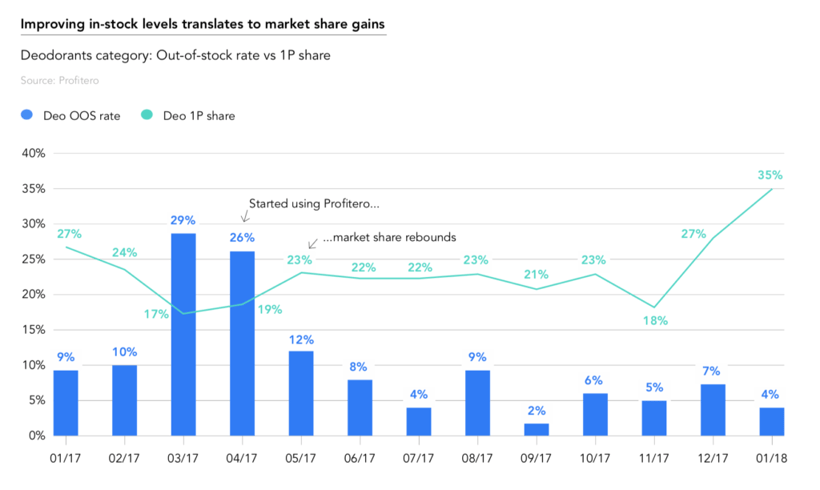

A top 3 player in the intensely competitive online personal care space was losing sales and share on Amazon 1P (products sold and distributed directly by the retailer), largely because of out-of-stock issues. The manufacturer found out the hard way that it doesn’t matter how good your content or traffic rates are if the online retailer doesn’t have enough stock on hand to make the sale.
Learn how fixing out-of-stocks on Amazon enabled this leading personal care products manufacturer to cut its sales loss by nearly a third and increase share by 2.7pp.
Challenge
Monitoring out-of-stocks and fixing inventory issues is a quick and cost-effective path to boosting eCommerce sales—and it just makes good business sense. Consequently, product availability became a top priority for the personal care manufacturer. The company set a goal of having no more than a 5% out-of-stock (OOS) rate on Amazon 1P.
In late 2016 into early 2017, the manufacturer found OOS on Amazon was consistently creeping above its acceptable threshold. It sought to identify which, if any, specific categories and ASINs were most at risk due to high OOS rates. Only then could it open up discussions with Amazon to adjust inventory levels accordingly.
Solution
Using Profitero’s Assortment & Availability analytics, the personal care manufacturer began routinely monitoring out-of-stock rates across its portfolio of 20+ categories. Not only was the company able to pinpoint what categories and SKUs had the highest OOS rates, they also were able to quantify the size of the lost opportunity.
“Deodorant” was found to be the main category with the greatest OOS issue—topping out at 29% and 26% OOS, respectively in March and April 2017. Because product supply was low or unavailable for purchase, the company was losing out to competitive brands and saw its share sink 7pp from February to March 2017.
Armed with these data-driven insights and metrics, the manufacturer was positioned to negotiate better inventory and supply terms with Amazon. It was able to clearly demonstrate how increasing inventory levels and improving product availability was a win-win-win: satisfying consumer demand while increasing sales for both Amazon 1P and the manufacturer itself.

Result
Using Profitero’s data, the personal care manufacturer was able to decrease OOS rates in the Deodorants category from double-digits to low single-digit levels during 2H 2017. In fact, the manufacturer boasted a record-breaking 2% OOS rate in September 2017. As a result, the company saw its share of the Deodorants category on Amazon 1P increase 8pp year-over-year, from 27% share in January 2017 to 35% in January 2018.
Across its broader product portfolio, the manufacturer cut its sales loss by nearly a third, just by tracking out-of-stock rates and focusing on categories with the highest sales losses. Because more product was available, overall market share across all categories grew by 2.7pp, from 7.8% at the end of 2016 to 10.5% at the end of 2017.


























